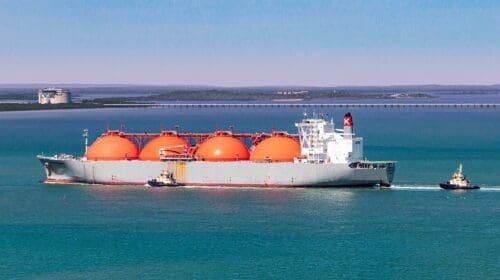Demand for natural gas has surged in recent years as economies around the world realize its value.
Consumers in the U.S. use natural gas to warm their homes, cook dinner and in some cases as a transportation fuel. Its largest consumers, however, are electric utilities.
The Energy Information Administration (EIA) expects U.S. total consumption of natural gas will average 84.1 billion cubic feet (Bcf/d) in 2022, up 1 percent from 2021.
“The increase in U.S. natural gas consumption is a result of colder forecast temperatures in 2022 compared with 2021, which results in more consumption in the residential and commercial sectors,” EIA stated in its monthly report for March. “In addition, we expect the industrial sector to consume more natural gas in 2022 in response to expanding economic activity.”
A growing part of the natural gas business is exports of liquefied natural gas (LNG) from the U.S. to other countries. In March, U.S. LNG exports averaged 11.9 Bcf/d, an increase of 0.7 Bcf/d from February.
“LNG prices in Europe remain high amid supply uncertainties due to Russia’s further invasion of Ukraine and the need to replenish Europe’s natural gas inventories, which has kept Europe’s demand for LNG elevated,” EIA stated. “Inventories in Europe were 26 percent full as of March 31, compared with the five-year average of 34 percent. We expect high levels of U.S. LNG exports to continue in 2022, averaging 12.2 Bcf/d for the year, a 25 percent increase from 2021.”
EIA estimates U.S. natural gas inventories ended March at 1.4 trillion cubic feet (Tcf), which is 17 percent below the five-year (2017–2021) average. Inventory withdrawals in March were 203 billion cubic feet (Bcf), resulting from relatively flat production and rising natural gas exports.
“We expect natural gas inventories to increase by 245 Bcf in April, as the injection season begins, ending the month at about almost 1.7 Tcf, which would be 14 percent below the five-year average for this time of year,” EIA said. “We forecast that natural gas inventories will end the 2022 injection season (end of October) at 3.5 Tcf, which is 4 percent below the five-year average.”
In March, the Henry Hub natural gas spot price averaged $4.90 per million British thermal units (MMBtu), which was up from the February average of $4.69/MMBtu. EIA expects the Henry Hub price will average $5.68/MMBtu in 2Q22 and $5.23/MMBtu for all of 2022. Natural gas closed at $6.86 on April 26.
EIA forecasts U.S. production to average 96.9 Bcf/d in April and average 97.4 Bcf/d for all of 2022, which is a 3.8 Bcf/d increase over 2021.
Even though EIA believes natural gas consumption will increase 1 percent this year, it will lose 2 percent of the electricity generating business to wind and solar. Natural gas generation is expected to drop from 37 percent in 2021 to 35 percent this year. EIA said electricity generation from renewable energy sources will rise from 20 percent in 2021 to 22 percent in 2022.
Alex Mills is the former President of the Texas Alliance of Energy Producers.
Alex Mills is the former President of the Texas Alliance of Energy Producers. The Alliance is the largest state oil and gas associations in the nation with more than 3,000 members in 305 cities and 28 states.
Oil and gas operations are commonly found in remote locations far from company headquarters. Now, it's possible to monitor pump operations, collate and analyze seismic data, and track employees around the world from almost anywhere. Whether employees are in the office or in the field, the internet and related applications enable a greater multidirectional flow of information – and control – than ever before.










